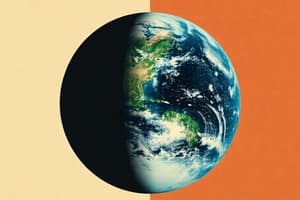Podcast
Questions and Answers
Explain how the tilt of Earth's axis and its orbit around the Sun contribute to the changing seasons.
Explain how the tilt of Earth's axis and its orbit around the Sun contribute to the changing seasons.
The tilt causes different hemispheres to receive more direct sunlight at different times of the year, and the orbit determines Earth's position relative to the Sun, affecting the intensity and duration of sunlight.
Describe the relationship between Earth's rotation and the apparent rising and setting of the Sun.
Describe the relationship between Earth's rotation and the apparent rising and setting of the Sun.
Earth's rotation on its axis causes the Sun to appear to move across the sky from east to west. As Earth rotates, different locations on the surface move into and out of sunlight.
How does the Moon's revolution around the Earth and its own rotation result in us always seeing the same side of the Moon?
How does the Moon's revolution around the Earth and its own rotation result in us always seeing the same side of the Moon?
The Moon is tidally locked with Earth, meaning its rotation period is equal to its orbital period. This synchronous rotation causes the same side of the Moon to always face Earth.
Explain the positioning of the Sun, Earth, and Moon during a new moon, and how this alignment affects the Moon's visibility.
Explain the positioning of the Sun, Earth, and Moon during a new moon, and how this alignment affects the Moon's visibility.
Describe the difference between inner and outer planets in our solar system, in terms of their composition and location relative to the Sun.
Describe the difference between inner and outer planets in our solar system, in terms of their composition and location relative to the Sun.
Explain why comets develop a bright tail when they approach the Sun.
Explain why comets develop a bright tail when they approach the Sun.
Explain how the gravitational attraction of clouds of hydrogen gas and dust leads to the formation of a star.
Explain how the gravitational attraction of clouds of hydrogen gas and dust leads to the formation of a star.
Describe what occurs in the core of a star during nuclear fusion and what elements are involved.
Describe what occurs in the core of a star during nuclear fusion and what elements are involved.
Distinguish between a red giant and a red supergiant star in terms of their mass and eventual fate.
Distinguish between a red giant and a red supergiant star in terms of their mass and eventual fate.
Briefly describe the defining characteristic of a black hole and explain why it is difficult to observe directly.
Briefly describe the defining characteristic of a black hole and explain why it is difficult to observe directly.
Explain the concept of 'redshift' and how it provides evidence for the expansion of the universe.
Explain the concept of 'redshift' and how it provides evidence for the expansion of the universe.
Explain the significance of microwave background radiation as evidence supporting the Big Bang theory.
Explain the significance of microwave background radiation as evidence supporting the Big Bang theory.
Describe how Hubble's Law relates the speed of a galaxy's recession to its distance from us.
Describe how Hubble's Law relates the speed of a galaxy's recession to its distance from us.
What ingredients are needed for nuclear fusion to occur in a star?
What ingredients are needed for nuclear fusion to occur in a star?
Explain why inner planets are composed of mainly metals and silicates.
Explain why inner planets are composed of mainly metals and silicates.
Flashcards
What causes day and night?
What causes day and night?
Earth spinning on its axis, resulting in day and night
Why does the Sun appear to move?
Why does the Sun appear to move?
The Earth's rotation makes the Sun appear to move across the sky from east to west.
What causes seasons?
What causes seasons?
Earth's orbit around the Sun and the tilt of Earth's axis.
What is the Moon?
What is the Moon?
Signup and view all the flashcards
Name the Moon phases.
Name the Moon phases.
Signup and view all the flashcards
What is Orbital Speed?
What is Orbital Speed?
Signup and view all the flashcards
What does Solar System contain?
What does Solar System contain?
Signup and view all the flashcards
Name the Inner Planets
Name the Inner Planets
Signup and view all the flashcards
Name the Outer Planets
Name the Outer Planets
Signup and view all the flashcards
What are Asteroids?
What are Asteroids?
Signup and view all the flashcards
What are Comets?
What are Comets?
Signup and view all the flashcards
What are Elliptical Orbits?
What are Elliptical Orbits?
Signup and view all the flashcards
How Solar Systems form?
How Solar Systems form?
Signup and view all the flashcards
What is the sun mostly made of?
What is the sun mostly made of?
Signup and view all the flashcards
What is the Milky Way?
What is the Milky Way?
Signup and view all the flashcards
Study Notes
The Earth and the Solar System
- Earth spins on its axis, causing day and night.
- A complete rotation takes 24 hours.
- Day occurs on the half of Earth facing the Sun, while night is on the half facing away.
Rising and Setting of the Sun
- Earth's rotation makes the Sun appear to move east to west.
- The Sun rises exactly in the east and sets exactly in the west during equinoxes.
- In the northern hemisphere during summer, the Sun rises north of east and sets north of west.
- In winter, the Sun rises and sets south of these points.
The Seasons
- The seasons result from Earth's motion around the Sun (365 days) and the tilt of Earth's axis.
Motion of the Moon
- The Moon, a satellite of Earth, orbits approximately every month.
- The average distance from Earth is about 400,000 km.
- The Moon revolves on its axis, always showing the same side to Earth.
- The Moon reflects sunlight, has no atmosphere, and has a weaker gravitational field (one-sixth of Earth).
Phases of the Moon
- The Moon's appearance changes during its monthly orbit.
- During the New Moon, the Moon is between the Sun and Earth, with its unlit side facing Earth.
- A crescent appears and increases until the first quarter, where half of the Moon is visible.
- The Full Moon occurs when the Moon is opposite Earth from the Sun and is fully visible.
- Waning phases follow as the moon's illumination decreases.
Orbital Speed
- Average orbital speed (uu) is calculated as 2πr/T, where rr is the average radius of the orbit and TT is the orbital period (time for one orbit).
- The Moon travels in a circular path around the Earth, and the distance traveled in one orbit is the circumference of the circle, 2πr.
- Time taken for one orbit is TT, and speed is distance divided by time.
The Solar System
- It consists of the Sun as a star, eight planets in elliptical orbits, dwarf planets and asteroids orbiting the Sun, moons orbiting planets, and smaller bodies like comets and natural satellites.
Inner Planets
- The inner planets are Mercury, Venus, Earth, and Mars, and they are small and similar in size.
- They are solid and rocky with layered structures and high density.
- Inner planets formed close to the Sun, where it was too hot for gases to condense, allowing only metals and silicates to form solid bodies.
- In the early Solar System, the Sun's heat caused lighter gases to evaporate, leaving only heavy elements like iron and silicon to form solid planets.
Outer Planets
- The outer planets are Jupiter, Saturn, Uranus, and Neptune, and they are much larger and colder than the inner planets.
- They are mainly composed of gases and have low density, with many moons and rings of icy materials.
- Outer planets formed in cooler regions where gases could condense, capturing even the lightest elements.
- In the outer regions of the Solar System, lower temperatures allowed gases like hydrogen and helium to remain in solid or liquid forms, forming gas giants with thick atmospheres.
Asteroids
- Asteroids are pieces of rock of various sizes, mostly located between Mars and Jupiter.
- They orbit around the Sun and have a similar density to inner planets.
- Some asteroids burn up in Earth's atmosphere as meteors.
Comets
- Comets consist of dust embedded in ice made from water and methane.
- They orbit the Sun in highly elliptical paths and develop a bright tail when approaching the Sun due to radiation pressure.
Elliptical Orbits
- Planets, dwarf planets, and comets orbit the Sun in an ellipse.
- The Sun is at one focus of the ellipse, not the center.
- Comets have highly elliptical orbits, while planets' orbits are more circular.
Origin of the Solar System
- The Solar System formed from gravitational attraction pulling together clouds of hydrogen gas and dust (nebulae) about 4.5 billion years ago.
- Planets formed from the disc of matter left over from the nebula that formed the Sun.
- Inner planets were formed from materials with high melting temperatures, such as metals and silicates.
- Outer planets formed from light molecules that existed in solid icy forms, growing large enough to capture hydrogen.
Travel Times
- The distance from the Sun to Earth is approximately 150 million km.
- Light travels at 300,000 kilometers per second.
- Light from the Sun takes about 8 minutes to reach Earth.
The Sun
- The sun is a medium-sized star composed mainly of hydrogen and helium.
- It emits energy in the infrared, visible, and ultraviolet regions of the electromagnetic spectrum.
- Energy comes from nuclear reactions in the core, where hydrogen undergoes nuclear fusion to form helium, releasing energy.
- Energy from the core heats outer layers, causing them to glow and emit radiation.
Nuclear Reactions in Stars
- Stars like the Sun are powered by nuclear fusion.
- Core needs to be hot and dense enough for hydrogen to fuse into helium.
- Fusion releases energy, maintaining high core temperatures.
- Some core energy moves to outer layers, and emits electromagnetic radiation.
Light Years
- A light-year is the distance light travels in a vacuum in one year, equivalent to 9.5×10^12 km.
Galaxies
- Galaxies are large collections of stars, gas, and dust.
Origin and Lifecycle of Stars
- Stars form when interstellar clouds of dust and gas collapse under gravitational attraction.
- A protostar forms as mass increases and core temperature rises.
- Hydrogen fuses into helium when the core becomes hot enough, resulting in a star.
Star Types
- Large mass stars are blue or white.
- Smaller mass stars are yellow or red dwarfs.
Life Cycle of Stars - Stable Phase
- Forces of gravity inward balance with thermal pressure outward.
- This lasts up to 10 billion years where hydrogen converts to helium in the core.
Red Giant/Red Supergiant
- As hydrogen depletes, the star becomes unstable.
- The core collapses, and outer layers expand and cool.
- The star turns into a red giant (or red supergiant if massive).
- Helium fuses into carbon in the core.
Low Mass Stars - End Stage
- The core collapses into a white dwarf after all helium is used.
- Outer layers are expelled, forming a planetary nebula.
- White dwarf cools into a black dwarf over about a billion years.
High Mass Stars - End Stage
- High mass stars, more than 8 times the Sun's mass, use hydrogen rapidly, with a shorter stable phase (about 100 million years).
- After helium fusion, the core collapses into a red supergiant.
- Fusion of carbon into heavier elements occurs until iron forms.
- A supernova explosion releases energy and heavy elements into space.
- Neutron Star: Dense core that may act as a pulsar.
- Black Hole: Extremely dense core with a gravitational field so strong that even light cannot escape, identified by X-ray radiation from nearby material.
The Universe
- Milky Way: Approximately 100,000 light-years in diameter and contains around 800 billion or more stars, presenting as a spiral galaxy with a central bulge and spiral arms.
Redshift
- Light from distant galaxies shifts towards the red end of the spectrum (longer wavelength).
- Light emitted from stars in distant galaxies appears redder compared to light from closer galaxies.
Doppler Effect
- It occurs when a source of waves, such as sound or light, moves relative to an observer.
- Approaching Source: Waves are compressed, and the frequency and pitch are higher (blue shift for light).
- Receding Source: Waves are stretched, and the frequency and pitch are lower (red shift for light).
Speed of Recession
- The speed at which distant galaxies are moving away can be calculated from the amount of redshift observed.
- Some of the most distant galaxies are receding at speeds up to one-third the speed of light.
- Observed redshift supports the Big Bang theory, because the Universe is expanding.
Big Bang Theory
- The Universe began from an extremely hot and dense state around 14 billion years ago.
- The expansion of the universe has been ongoing ever since.
Microwave Background Radiation
- Radiation is remnant from the Big Bang and fills the entire Universe.
- The radiation has been redshifted into the microwave region due to the expansion of the Universe.
- It provides strong evidence for the Big Bang theory.
Age of the Universe
- Use Hubble’s Law: v=H0×d, where v is the speed of recession and d is the distance of galaxies
- Hubble Constant (H0) measures the rate of the Universe's expansion, where a higher value indicates faster expansion.
- H0 is estimated to be approximately 2.2×10−18 s−1.
- The estimated age of the Universe is approximately 1/H0.
Studying That Suits You
Use AI to generate personalized quizzes and flashcards to suit your learning preferences.




